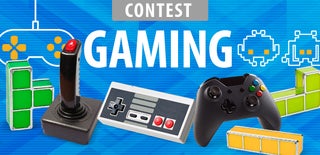Introduction: Make a Raspberry Pi Console
In this instructable you will be able to make your own cool and retro console to show off to all your friends. This will go through all the steps from software to building and it is beginner friendly. If you enjoy this instructable please vote for this in the contests by clicking on vote at the top of the instructible. Anyway lets get started.
Step 1: Setting Up Your Raspberry Pi
This first step goes through just setting it up so you can test out the software. This step is first so you can know what you are going to need hardware wise later.
So you are going to need a raspberry pi which can be any model, a micro usb cable with plug (type b micro usb), a screen with hdmi input, a hdmi cable, a keyboard or game controller and at least a 4gb class 4 memory card. You should also get a external usb port and a mouse.
Now that you have got all you need to test it out lets go and get the software. For this you will need a computer, and win32 disk imager which you can download from here.
https://sourceforge.net/projects/win32diskimager/f...
Now that you have downloaded that we can get the operating system for the pi. We will be using retro pie which is a free operating system which boots onto emulation station which will run all of our games. You can download it from here for your version of the pi.
http://blog.petrockblock.com/retropie/retropie-dow...
Once you have downloaded that we can put it onto the sd card (but make sure the sd card is empty first)! So first of all open up win32 disk imager. Next press the file button to find retro pie which you have just downloaded which should be in the download file unless you moved it. Then click on the device button and select in what drive your sd card is in which should be the :f drive. Then click write. Once you have done that you can take the sd card out your computer and put it into your raspberry pi.
Now turn on your raspberry pi. It will now load up showing the retro pie start screen which you can later to one of their other ones or even your own image. After that it will show the emulation station start up screen for around half a minute. The first time you use emulation station it will go onto a screen where you assign your keys. Just simply press the key you want depending on what thing it is on (for example if it is on start you could press space). If you don't want to use a certain key press and hold an already used button. If you wish to change what you have put use the keys or buttons you have assigned to d-pad up and down and the a button to change different things. Finally use the key or button for your a button to press ok.
You are now onto the main emulation station. From here you can go on different systems. There are a few games that you can play. This includes zork 1,2 & 3 a text based adventure for the infocom and are a few games in the port section including doom and quake 3. Now we have done that on the next step I will show you how to add your own roms onto emulation station.
Step 2: Adding Your Own Games
It is very simple to add your own games. All you need to do is download roms from the internet which you own an original copy of. Then it is quite simple. First the best ways to do it is either connecting your computer and raspberry pi by Ethernet cable, getting a wifi dongle for your raspberry pi and setting up the internet or connecting your raspberry pi to your wifi box to connect it to the internet. To set up your wifi on to the raspberry pi on the menu for emulation station and go onto retro pie. After that go onto configure wifi settings and then chose your wifi and put the password in. Now we can get on to putting the games on. So to do that first make sure you have your raspberry pi on either connected by Ethernet to the computer or connected to the internet. Now go onto file explorer and then onto network. After loading it should show up with any computers connected to your internet and also RETROPIE which is the raspberry pi. from there go onto roms and then pick any of the systems you have roms for and drag and drop them in there. Once you have done adding all of your games you will need to reboot your raspberry pi for the games to show up. And there we have it you are done. The next step will be on creating a custom splash screen (the loading screen before it goes onto emulation station) and we will be looking at some of the other setting to customize your system.
Step 3: Customizing Retro Pie and Emulation Station
In this step we will be going through the different things that you can do to customize retro pie and emulation station for your personal needs.
One of the first things that you will notice right away is the splash screen. This is the screen that it shows before going onto emulation station. To make it look more professional you can add your own custom splash screen. To do this the first thing you will need is a picture editor. I use GIMP as it is free and is like Photoshop. Here is the link for it below.
Now you have installed GIMP here as some instructions in making a custom splash screen. First of all you need to click on file and then click on new. I would recommend setting the image size to 720 (1280 by 720) because most monitors as that size or more. Then fill the background with whatever you want. I would just use the fill tool and fill the background black. Then next to make your splash screen copy some high quality logos from online (I am making a pistation so I got the playstation logo and the raspberry pi logo). When pasting them paste them on different layers so for the first image go onto layer and then new layer and keep it the same size. Now do the same with the other image(s). To change between layers press page up and page down on your keyboard. Now to remove the background of the images you do this. Go onto the layer of the image you wish to do first. You will need to use the colour picker tool to find out the background colour. Now click on the colour box which just changed colour when you clicked on the background. Now copy the html notation. Now exit that. Next click on colours and then colour to alpha. This will make the chosen colour become transparent. Click on the colour box and paste your html notation. Now you can do that with the rest of the images. You can also use the fuzzy select tool (magic wand). Now click on the background area and now right click, then go on edit and then cut. Now you have done that you can use the fuzzy select tool to get rid of any parts of the logos if wish. Now you are ready to resize the logos. To do that go onto the layer of either one of the images. Right click somewhere on the layer, then click on layer and then scale layer. Scale it to any size you like then do it with the other image. The use the move tool to move them where you like. Now you can add any of your own features like text etc. Once you have finished first of all go into file and save it (so that you can edit it later if you need to) and then export it to whatever you like. And now you are done. Next we need to import it onto the raspberry pi. This is how to do that. So first have your computer and raspberry pi turned on. Now once on emulation station quit it so you are on the raspberry pi start up. Now to be able to change splash screen it must be on the home of the pi. So for this we will need to download FileZilla. This will transfer files between the raspberry pi and pc. On emulation station in the retropie settings you can find the ip address of your raspberry pi. And on FileZilla fill in the user name and password as pi and raspberry unless you have changed the user name and password. If you have set it as that. If you need any more help look on this webpage.
Step 4: The Design
Here are some ideas you could do if you want a handheld console. You could design it like the game bot with screen at the top and buttons at the bottom or like the neo geo with screen in the centre. Or it could be like the psp with the extra joysticks for 3d games. Or you could do a plug and play controller for portability. Another thing on the line of that you could do something like the NVidia shield 2 console. And last of all you could do something like the good old ds with a touch screen at the bottom and normal screen at the top. Next we will look at some normal console designs.
Here are a few designs you could do for a normal console. You could do a console designed like the ps1 with separate plug in controllers or like a arcade machine with built in controls. It is all up to you. The next step will go over the parts you need.
Step 5: Parts You Will Need
Now you need to consider the parts you will get depending on how you have decided your retro pie to look. In my case I designed my retro pie like playstation so I am getting a usb playstation controller port. This means I can connect ps1 and 2 controllers to it. Here is the link where I bought it from.
http://www.ebay.co.uk/itm/201529253616
But you could use anything like that or if you like just use usb. I have got an unused computer fan which I am using with mine. You do not need one but I have one just to be safe. Next I have an unused laptop speaker which I am going to use for audio in case I use it with a monitor without speakers. If you would like you could turn it into a portable console like a gameboy and you could buy a small screen, a rechargeable battery and have a built in controller. I am using a usb hub so I can connect things inside like the wifi dongle and the usb ps2 controller port. With the remainding two usb ports I am going to desolder them and have them on the outside unless I want to plug in a usb controller ect. I have also used this one because it is cheap and very small so it can fit inside easily. Here is the link where I bought it from.
http://www.ebay.co.uk/itm/High-Speed-4-Port-USB-2-...
Other than that you can use whatever you want to use and the things on step one. In the next step we will be looking at the diagram of it all set up and where to wire things.
Step 6: Electrics Diagram
This is a simple step of showing where everything in my project is wired up. In the next step we will be designing the shell for our raspberry pi console.
Step 7: Designing the Shell
So now we have seen how all the electronics wire up we can design a shell for it all. For designing things to be cut onto the laser cutter I usually use 2d design. But that is not free and the demo you cannot save it or export what you have made to be cut. So we are going to use inkscape. A lot of you will probably know inkscape as an art software but you can also use it to laser cut. It is not as professional but we can still use it well. So here is where you download it from. In the picture is my finished design on 2d design.
https://inkscape.org/en/download/
Now you have downloaded it we need to get one more thing the laser cutting extension. Here is the download link.
http://jtechphotonics.com/?page_id=1980
Now we have that we need to export the extension into inkscape. To do that open up file explorer and go onto my computer or this pc. Then go onto the c drive and then onto program files. You should see a file in there called inkscape. Go onto it. Now go onto share and then onto extensions. Now you need to extract the laser cutter extension and copy its contents into the extensions folder. Now you can get on to drawing. There are many tools to use and also extensions. Now go ahead and make a creative design. If you need help check out this tutorial.
https://inkscape.org/en/learn/
Once you have drawn out your object it is quite simple. First of all you need to group together everything you have done. Next you need to select it and go on the top bar to path and then object to path. After that go onto extensions, then generate laser gcode. Now change the settings as you wish it will be now exported as gcode. If you need more of a detailed tutorial go onto this link.
http://jtechphotonics.com/?page_id=2012
When making it I would add some sort of gap for the fan and just for natural cooling. Also you need to think what material you want it to be from. You could even have different materials for different parts. For example the top, front and sides could be retro looking wood so it looks nice for those who see and then plastic for the back and bottom.
The next step will be about connecting all the electronics together.
Step 8: Connecting the Electronics
In this step we will be connecting the electronics. For this you may need a solder if you have any computer parts which don't have usb connection. So first of all you are going to need to find out what each wire is and then work out where you need to put it on the raspberry pi gpio in the pictures above. Then warm up your soldering iron to the correct heat and solder it to the correct parts. Do the same with the remaining parts and you are done.
Now you need to do the final build. It is as simple as putting all the parts inside and gluing it all together. Now you can add extra things to make it look nice.
In the next step you will see some extra cool features.
Step 9: Extra Cool Features
In this step we will be adding some small features to make your console even cooler!
First of all you could add your own decals. In order to do this it is quite simple. You will need to buy some decal paper which is not too expensive.
http://www.ebay.co.uk/itm/5-Sheets-A4-Inkjet-Water...
You will also need an inkjet printer. So now on a computer create some things that could be decals. These could be logo's, pictures to show what goes in each port or just to make your console more creative. For example you could use the logo you created in the other step. Once you have made or sourced your images you will need to print it. If you do not have Microsoft office here are some other ones you could use.
Now you can use one of the different applications like the version of word or you could use the draw application. When you have inserted your image when you print it out you may find when you print it, it might be smaller than on screen as the printer might have a safety border. Before printing use as mush space on the sheet as possible so you don't waste money. Now print it out. Once you have printed it out stick it onto your console where ever you like.
Another cool thing you could do is make an instructions manual. You could use your images for logo's and then explain how to use and the features for your console.
Another thing you could do is create your own controller. In order to do that you will need a keyboard that you don't use any more, some small momentary push buttons, a case which you could create yourself and a soldering iron. There are plenty of tutorials online on how to do it.
In the picture at the top it shows a ps3 controller with a camo decal on.
In the next step we will look at the end result.
Step 10: End Results
And now we are done. Now you have your own retro console to show off with all your freinds. If you have found this instructible useful please vote for this instructible in the contests. If you have any questions feel free to ask me below. Thank you and I hope you enjoyed!

Participated in the
Gaming Contest

Participated in the
Raspberry Pi Contest 2016

Participated in the
Full Spectrum Laser Contest 2016










